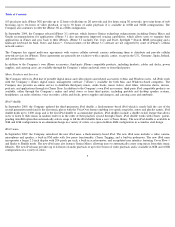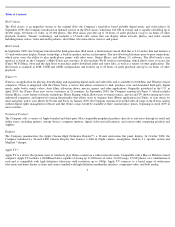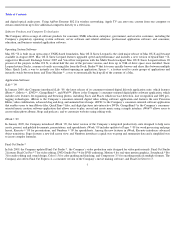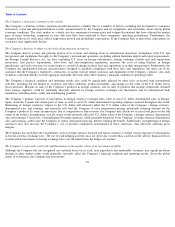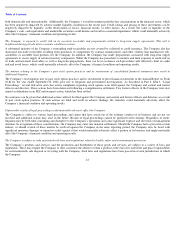Apple 2009 Annual Report Download - page 18
Download and view the complete annual report
Please find page 18 of the 2009 Apple annual report below. You can navigate through the pages in the report by either clicking on the pages listed below, or by using the keyword search tool below to find specific information within the annual report.
Table of Contents
imitate the Company’
s approach to providing these components seamlessly within their individual offerings or work collaboratively to offer
integrated solutions.
The Company currently receives subsidies from its exclusive and non-
exclusive carriers providing cellular network service for iPhone. There is
no assurance that such subsidies will be continued at all or in the same amounts upon renewal of the Company’
s agreements with these carriers
or in agreements the Company enters into with new carriers.
There can be no assurance the Company will be able to continue to provide products and services that compete effectively.
To remain competitive and stimulate customer demand, the Company must successfully manage frequent product introductions and transitions.
Due to the highly volatile and competitive nature of the personal computer, mobile communication and consumer electronics industries, the
Company must continually introduce new products, services and technologies, enhance existing products and services, and effectively stimulate
customer demand for new and upgraded products. The success of new product introductions depends on a number of factors including but not
limited to timely and successful product development, market acceptance, the Company’
s ability to manage the risks associated with new
products and production ramp issues, the availability of application software for new products, the effective management of purchase
commitments and inventory levels in line with anticipated product demand, the availability of products in appropriate quantities and costs to
meet anticipated demand, and the risk that new products may have quality or other defects in the early stages of introduction. Accordingly, the
Company cannot determine in advance the ultimate effect of new product introductions and transitions on its financial condition and operating
results.
The Company faces substantial inventory and other asset risk.
The Company records a write-
down for product and component inventories that have become obsolete or exceed anticipated demand or net
realizable value and accrues necessary cancellation fee reserves for orders of excess products and components. The Company also reviews its
long-
lived assets for impairment whenever events or changed circumstances indicate the carrying amount of an asset may not be recoverable. If
the Company determines that impairment has occurred, it records a write-
down equal to the amount by which the carrying value of the assets
exceeds its fair market value. Although the Company believes its inventory and other asset related provisions are currently adequate, no
assurance can be given that, given the rapid and unpredictable pace of product obsolescence in the global personal computer, mobile
communication, and consumer electronics industries, the Company will not incur additional inventory or asset related charges. Such charges
have, and could, materially adversely affect the Company’s financial condition and operating results.
The Company must order components for its products and build inventory in advance of product announcements and shipments. Consistent with
industry practice, components are normally acquired through a combination of purchase orders, supplier contracts, open orders and, where
appropriate, prepayments, in each case based on projected demand. Such purchase commitments typically cover forecasted component and
manufacturing requirements for 30 to 150 days. Because the Company’
s markets are volatile, competitive and subject to rapid technology and
price changes, there is a risk the Company will forecast incorrectly and order or produce excess or insufficient inventories of components or
products. The Company’
s financial condition and operating results have been in the past and could be in the future materially adversely affected
by the Company’s ability to manage its inventory levels and respond to short-term shifts in customer demand patterns.
Future operating results depend upon the Company
’
s ability to obtain key components including but not limited to microprocessors, NAND flash
memory, DRAM and LCDs at favorable prices and in sufficient quantities.
Because the Company currently obtains certain key components including but not limited to microprocessors, enclosures, certain LCDs, certain
optical drives, and ASICs, from single or limited sources, the Company is
15


